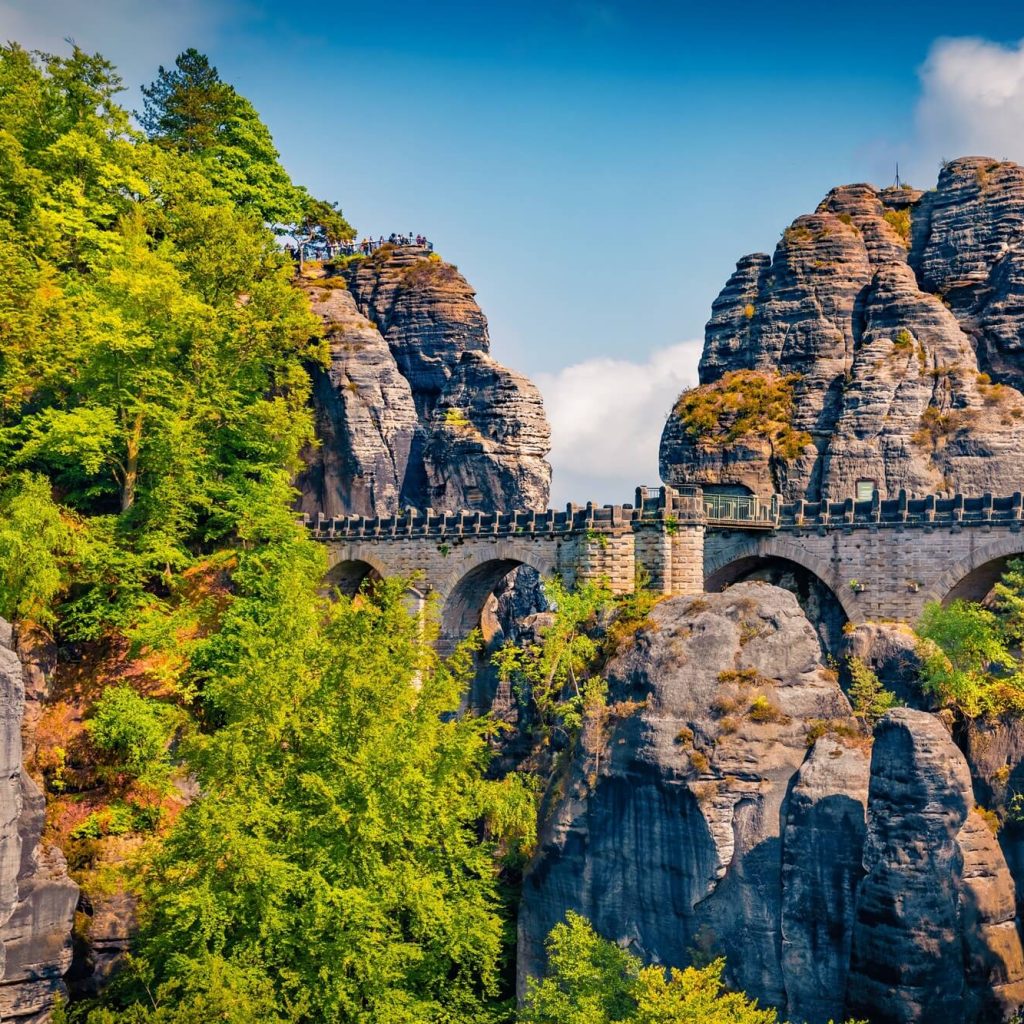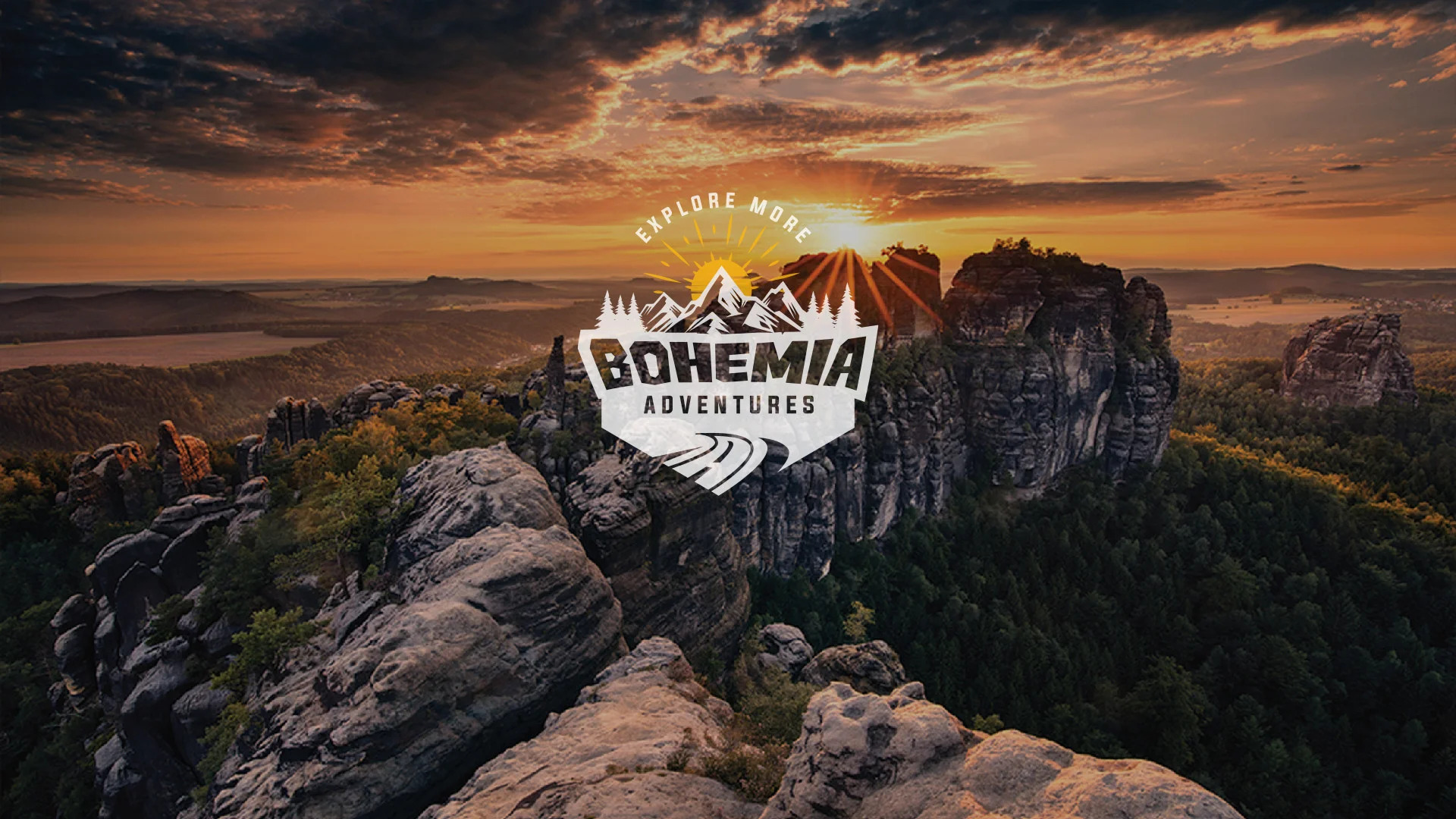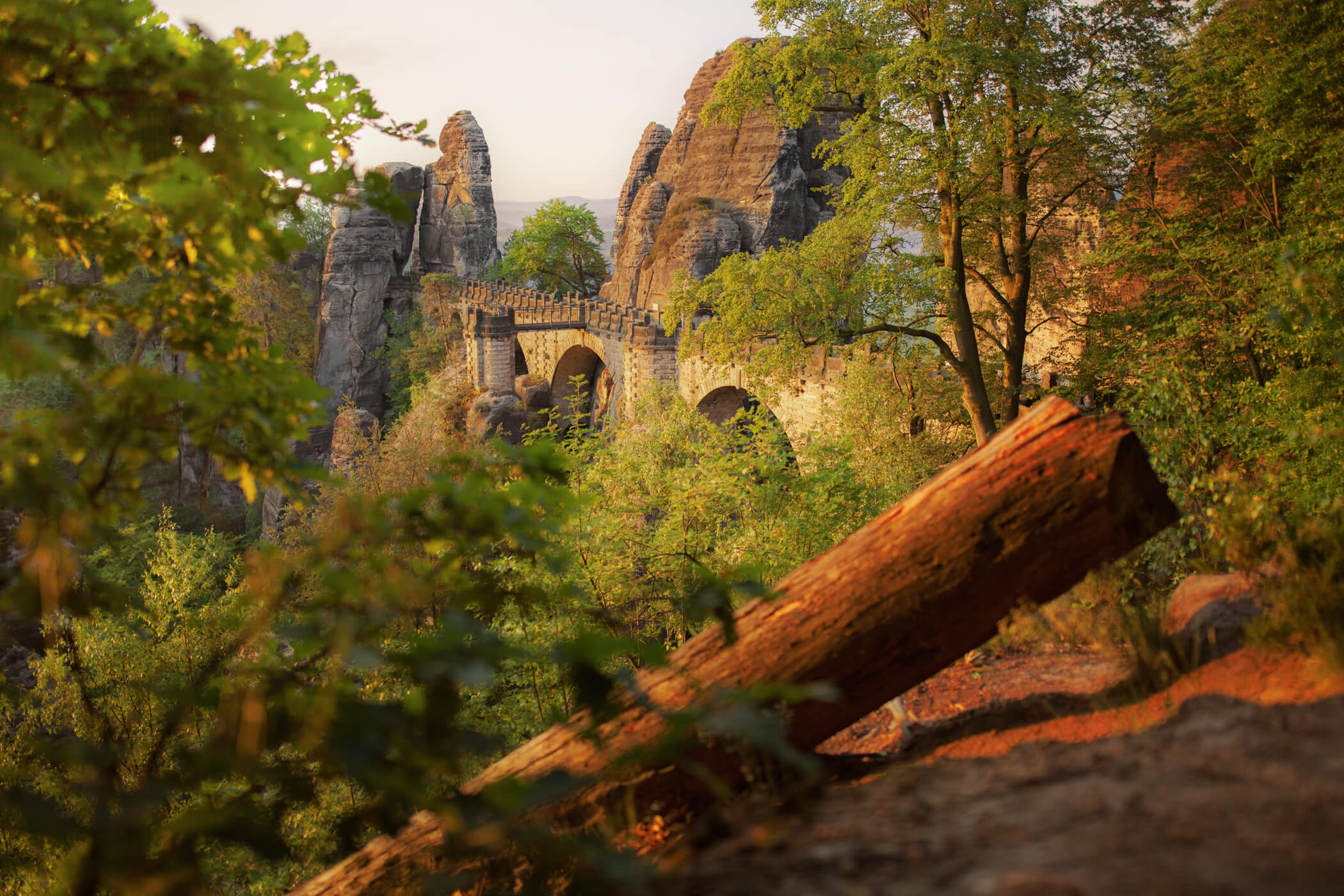Nestled amid the enchanting landscapes of the Saxon Switzerland National Park, the Bastei Bridge stands as a testament to nature’s artistry and human ingenuity. This iconic natural wonder, with its dramatic sandstone cliffs and panoramic vistas, offers a breathtaking escape for adventurers and nature enthusiasts alike. As you traverse the bridge, you’ll be captivated by the stunning views of the Elbe River and the surrounding lush valleys. Whether you’re a seasoned hiker or a casual visitor, the Bastei Bridge invites you to explore its rugged beauty and rich history. From the fascinating rock formations to the nearby medieval castle ruins, there’s so much to discover. Join us as we uncover the incredible features and tips for experiencing this magnificent landmark, ensuring your visit to Germany’s Bastei Bridge is unforgettable. Prepare to be awed and inspired by one of Germany’s most cherished destinations!
The History of Bastei Bridge

The Bastei Bridge, with its remarkable structure and awe-inspiring presence, has a rich and fascinating history that dates back to the early 19th century. Initially, it was a wooden bridge constructed in 1824 to provide access to the spectacular rock formations. This early bridge was built to cater to the growing number of visitors who were drawn to the region’s natural beauty. The Bastei area itself had already become a popular destination for travelers and artists seeking inspiration from its dramatic landscapes.
In 1851, the wooden bridge was replaced with a more durable sandstone structure that we see today. This transition marked a significant development in the accessibility and preservation of the area. The sandstone used for the bridge was sourced from the very cliffs that it spans, seamlessly blending the man-made structure with its natural surroundings. The construction of the sandstone bridge not only ensured greater durability but also enhanced the aesthetic appeal of the landmark, attracting even more visitors who marveled at its harmonious integration with the environment.
Over the years, the Bastei Bridge has witnessed the passage of countless travelers and the evolution of the region’s tourism industry. It stands as a symbol of the enduring allure of Saxon Switzerland National Park. The bridge has also been the subject of numerous artistic works, including paintings and photographs, further cementing its status as an iconic natural wonder. Today, the Bastei Bridge continues to captivate visitors with its historical significance and breathtaking vistas, offering a glimpse into the past while providing a timeless experience for all who cross it.
How to Get to Bastei Bridge
Reaching the Bastei Bridge is an adventure in itself, as the journey takes you through some of the most picturesque landscapes in Germany. The bridge is located within the Saxon Switzerland National Park, approximately 40 kilometers southeast of Dresden. This proximity to Dresden makes it an ideal day trip for those staying in the city. The most convenient way to reach the Bastei Bridge is by car. Visitors can take the A17 motorway from Dresden to Pirna and then follow the signs to the Bastei. There is a large parking area near the bridge where visitors can leave their vehicles before embarking on the short hike to the bridge.
For those who prefer public transportation, there are several options available. Trains run regularly from Dresden to the town of Rathen, which is the closest railway station to the Bastei Bridge. From Rathen, visitors can take a ferry across the Elbe River and then follow the well-marked hiking trails leading to the bridge. The hike from Rathen to the Bastei Bridge is moderately challenging, taking approximately 45 minutes to an hour, depending on your pace. Along the way, you’ll be treated to stunning views of the river and the surrounding countryside, making the journey as rewarding as the destination.
Another popular option is to join a guided tour from Dresden or other nearby cities. These tours often include transportation, a knowledgeable guide, and sometimes additional activities or visits to other attractions in the region. This option is particularly convenient for those who prefer a hassle-free experience and want to learn more about the history and geology of the area. Regardless of how you choose to get there, the journey to the Bastei Bridge is an unforgettable part of the experience, offering a taste of the natural beauty and charm that awaits you at the top.
Best Times to Visit Bastei Bridge
The Bastei Bridge is a year-round destination, each season offering its own unique charm and beauty. However, the best time to visit depends on your preferences and what you hope to experience. Spring, from April to June, is a particularly lovely time to visit. During this season, the surrounding forests come to life with vibrant greenery and blooming wildflowers. The weather is typically mild, making it ideal for hiking and exploring the area. Additionally, springtime tends to be less crowded than the peak summer months, allowing for a more tranquil and intimate experience.
Summer, from July to August, is the peak tourist season, attracting visitors from all over the world. The weather is warm and sunny, perfect for outdoor activities and photography. However, the popularity of the Bastei Bridge during this time means that the trails and viewing platforms can become quite crowded. If you plan to visit in the summer, it’s advisable to arrive early in the morning or later in the afternoon to avoid the largest crowds and to experience the bridge in a more peaceful setting.
Autumn, from September to November, is arguably the most picturesque time to visit the Bastei Bridge. The foliage transforms into a stunning palette of reds, oranges, and yellows, creating a breathtaking backdrop for the bridge and the surrounding cliffs. The cooler temperatures and fewer tourists make autumn an ideal time for hiking and photography. Winter, from December to February, offers a completely different experience. The landscape is often covered in a blanket of snow, and the bridge takes on a magical, almost otherworldly quality. While some trails may be more challenging or closed due to snow and ice, the winter scenery is enchanting and worth the effort for those who enjoy winter hikes and serene landscapes.
The Bastei Bridge is a year-round destination, each season offering unique charm and beauty:
- Spring (April to June): Mild weather, blooming wildflowers, fewer crowds.
- Summer (July to August): Warm weather, ideal for outdoor activities, busiest period.
- Autumn (September to November): Stunning autumn foliage, cooler temperatures, fewer visitors.
- Winter (December to February): Magical snowy landscapes, tranquil atmosphere, ideal for serene hikes.
Exploring the Surrounding National Park
The Saxon Switzerland National Park, home to the Bastei Bridge, is a vast and diverse natural wonderland that offers endless opportunities for exploration and adventure. The park covers an area of approximately 93 square kilometers and is characterized by its dramatic sandstone formations, dense forests, and winding rivers. One of the most popular activities in the park is hiking, with a network of well-marked trails that cater to all levels of experience and fitness. Whether you’re looking for a leisurely walk or a challenging trek, there’s a trail for you.
One of the must-see attractions within the park is the Schrammsteine rock formation, a series of jagged peaks that offer some of the most spectacular views in the region. The hike to the top of the Schrammsteine is moderately difficult, but the panoramic vistas from the summit are well worth the effort. Another popular trail is the Malerweg, or Painter’s Way, which is a long-distance hiking route that passes through some of the most scenic parts of the park. The Malerweg is named after the many artists who have been inspired by the area’s natural beauty, and it offers a wonderful way to experience the diverse landscapes of Saxon Switzerland.
In addition to hiking, the park offers a range of other outdoor activities. Rock climbing is a major draw, with the sandstone cliffs providing excellent climbing opportunities for both beginners and experienced climbers. The park is also a haven for wildlife enthusiasts, with a rich diversity of flora and fauna. Birdwatchers will be delighted by the variety of species that can be spotted, including the rare peregrine falcon. For those who prefer a more leisurely way to explore the park, boat trips on the Elbe River offer a unique perspective of the stunning landscapes and are a great way to relax and take in the scenery.
Saxon Switzerland National Park offers endless opportunities for exploration. Popular attractions include:
- Schrammsteine rock formation: Incredible views and moderately challenging hike.
- Malerweg (Painter’s Way): Scenic long-distance hiking route.
- Rock climbing: Opportunities for climbers of all levels.
- Wildlife watching and boat trips on the Elbe River.
Activities and Attractions Near Bastei Bridge
Beyond the Bastei Bridge itself, the surrounding area is rich with attractions and activities that cater to a wide range of interests. One of the top attractions nearby is the Königstein Fortress, one of the largest hilltop fortifications in Europe. Located just a short drive from the Bastei, the fortress offers a fascinating glimpse into the region’s military history and provides stunning views of the Elbe River and the surrounding countryside. Visitors can explore the well-preserved ramparts, underground casemates, and numerous museums housed within the fortress.
Another notable attraction is the town of Bad Schandau, a charming spa town located along the banks of the Elbe River. Bad Schandau is known for its historic thermal baths, which offer a relaxing way to unwind after a day of hiking and exploring. The town also features a picturesque old town with quaint shops, cafes, and restaurants, making it a pleasant destination for a leisurely stroll. For those interested in history and culture, the town’s museum provides insights into the area’s history, geology, and the development of tourism in the region.
For nature enthusiasts, a visit to the nearby Pravčická Brána is highly recommended. Located just across the border in the Czech Republic, the Pravčická Brána is the largest natural sandstone arch in Europe and one of the most impressive natural landmarks in the region. The hike to the arch takes you through beautiful forests and offers spectacular views of the surrounding landscapes. The nearby Hřensko Gorge is another natural wonder worth exploring, with boat rides available through the narrow, rocky canyons that provide a unique and memorable experience.
Beyond the bridge, explore attractions such as:
- Königstein Fortress: A historic hilltop fortification.
- Bad Schandau: A charming spa town with thermal baths.
- Pravčická Brána (Czech Republic): Largest natural sandstone arch in Europe.
- Hřensko Gorge: Scenic boat rides through picturesque canyons.

Would you like us to design your incredible day in Bohemian Switzerland?
Small Group Tours- Choose One of our small group tours from Prague, Meet and Travel with similar-minded people.
Private Tour- Travel with your own group or solo, 100% attention of our guide and tour designers to fit your expectations.
Premium Private Tour with Overnight Stay- Make the best out of your Czech Holidays and Experience this Czech wonderland in the best possible way with hidden spots, spas, and luxury with just the right mix of adventure.
Photography Tips for Capturing Bastei Bridge
The Bastei Bridge and its surrounding landscapes are a photographer’s dream, offering countless opportunities to capture stunning images. To make the most of your photography experience, it’s essential to plan your visit with lighting and composition in mind. One of the best times to photograph the Bastei Bridge is during the golden hours—shortly after sunrise and before sunset—when the light is soft and warm, casting a magical glow over the landscape. Arriving early in the morning also allows you to avoid the crowds and capture serene, unobstructed shots of the bridge and its surroundings.
When composing your shots, consider using the natural elements of the landscape to frame your images. The rugged sandstone cliffs, lush forests, and winding paths provide excellent opportunities for creative compositions. Experiment with different angles and perspectives to capture the bridge from unique viewpoints. For example, standing on the viewing platforms located along the hiking trails can offer breathtaking panoramic shots of the bridge and the Elbe River below. Additionally, incorporating people or other elements into your photos can add a sense of scale and depth, highlighting the grandeur of the bridge and its dramatic setting.
Utilizing a tripod can greatly enhance the quality of your photographs, especially in low-light conditions or when capturing long-exposure shots. A tripod provides stability and allows for precise adjustments to your camera’s position and settings. Long-exposure photography can create stunning effects, such as smooth, flowing water in the Elbe River or capturing the movement of clouds in the sky. For those interested in astrophotography, the clear night skies over the Saxon Switzerland National Park offer excellent opportunities to capture the stars and Milky Way. Be sure to bring a remote shutter release or use your camera’s timer function to minimize camera shake and achieve sharp, crisp images.
Enhance your photography with these tips:
- Visit during golden hours for best lighting.
- Use landscape elements for framing.
- Experiment with various angles and viewpoints.
- Bring a tripod for long-exposure shots.
Safety Tips for Visitors
While visiting the Bastei Bridge and the surrounding Saxon Switzerland National Park is a rewarding experience, it’s important to prioritize safety to ensure a pleasant and incident-free trip. The park’s rugged terrain and varying weather conditions require visitors to be well-prepared and cautious. One of the key safety tips is to wear appropriate footwear. Sturdy hiking boots with good traction are essential, as the trails can be uneven, steep, and slippery, especially after rain. Proper footwear will provide support and help prevent injuries.
It’s also crucial to stay on marked trails and follow the park’s guidelines. The trails are carefully designed to protect both visitors and the natural environment. Straying from the designated paths can lead to dangerous situations, such as getting lost or encountering unstable ground. Moreover, the park’s flora and fauna are delicate, and staying on the trails helps preserve the ecosystem. Always pay attention to signage and any warnings about trail conditions, closures, or potential hazards.
Weather in the region can be unpredictable, so it’s important to come prepared for changing conditions. Dress in layers to accommodate fluctuating temperatures and pack a waterproof jacket in case of rain. Carry enough water to stay hydrated, especially during warmer months, and bring snacks to keep your energy levels up. Additionally, having a basic first aid kit on hand is a good idea in case of minor injuries. Make sure to inform someone about your plans and expected return time, especially if you’re hiking alone. Mobile phone reception can be limited in some areas, so it’s wise to have a map and compass or a GPS device as a backup for navigation.
- Wear sturdy hiking boots.
- Stay on marked trails.
- Dress appropriately for weather conditions.
- Carry water, snacks, and a basic first aid kit.
Accommodations and Dining Options Nearby
When planning your visit to the Bastei Bridge, you’ll find a variety of accommodation options to suit different preferences and budgets. For those who prefer to stay close to the bridge, the village of Lohmen offers several charming guesthouses and small hotels. These accommodations provide a cozy and convenient base for exploring the Bastei and the surrounding national park. Many of these guesthouses offer a warm, homely atmosphere and personalized service, making your stay memorable and comfortable.
If you’re looking for a more luxurious experience, consider staying in Bohemian Homes or alternatively one of the boutique hotels in the nearby town of Bad Schandau. This spa town boasts several upscale hotels that offer a range of amenities, including spa facilities, fine dining, and beautiful river views. Staying in Bad Schandau also gives you the opportunity to explore the town’s historic thermal baths and enjoy leisurely strolls along the Elbe River. For a unique experience, some hotels in the area offer themed rooms and suites that reflect the region’s rich history and natural beauty.
For dining options, the region offers a delightful array of choices, from traditional German cuisine to international fare. Many of the guesthouses and hotels in Lohmen and Bad Schandau have on-site restaurants that serve hearty, local dishes made with fresh, regional ingredients. Be sure to try some of the Saxon specialties, such as Sauerbraten (marinated pot roast) and Quarkkäulchen (sweet cheese pancakes). There are also several quaint cafes and bakeries where you can enjoy coffee and pastries while taking in the scenic views. For a special dining experience, consider visiting one of the fine dining restaurants in Bad Schandau, which offer gourmet meals paired with excellent German wines.
Choose from cozy guesthouses in Lohmen, luxurious hotels in Bad Schandau, or charming dining options featuring regional cuisine. Try local specialties like Sauerbraten and Quarkkäulchen.
Conclusion: Why Bastei Bridge Should Be on Your Travel Bucket List
The Bastei Bridge, with its breathtaking views and rich history, is undoubtedly one of Germany’s most cherished natural wonders. Its dramatic sandstone cliffs and panoramic vistas create a surreal and enchanting atmosphere that captivates all who visit. Whether you’re a nature enthusiast, a history buff, or simply seeking a peaceful escape, the Bastei Bridge offers an unforgettable experience that will leave you in awe of the natural world.
The journey to the Bastei Bridge, whether by car, public transportation, or guided tour, is an adventure in itself, taking you through some of the most picturesque landscapes in Germany. The surrounding Saxon Switzerland National Park provides endless opportunities for exploration, from hiking and rock climbing to wildlife watching and boat trips. The park’s diverse landscapes and well-marked trails ensure that there’s something for everyone, regardless of age or fitness level.
Beyond the bridge, the region is rich with attractions and activities that cater to a wide range of interests. From the historic Königstein Fortress and the charming town of Bad Schandau to the stunning Pravčická Brána and Hřensko Gorge, there’s no shortage of wonders to discover. The area’s accommodations and dining options offer a delightful blend of comfort, charm, and regional cuisine, making your stay as enjoyable as it is memorable.
In conclusion, the Bastei Bridge is a must-visit destination that deserves a spot on your travel bucket list. Its unique blend of natural beauty, historical significance, and outdoor adventure makes it a perfect destination for travelers seeking an extraordinary and inspiring experience. Whether you’re capturing the perfect photograph, hiking through the stunning landscapes, or simply soaking in the serene vistas, the Bastei Bridge promises to leave you with lasting memories and a profound appreciation for one of Germany’s most iconic landmarks





Comment (0)